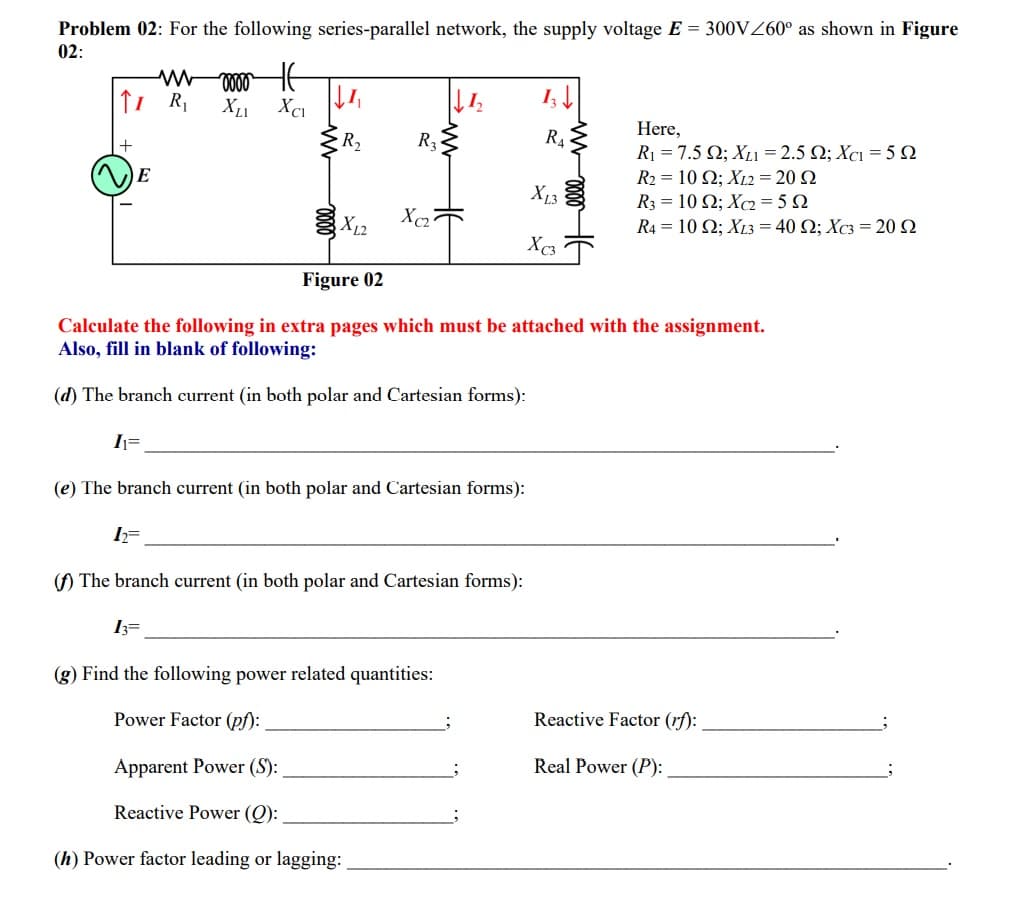(d) The branch current (in both polar and Cartesian forms): I= (e) The branch current (in both polar and Cartesian forms): () The branch current (in both polar and Cartesian forms): 13= (g) Find the following power related quantities: Power Factor (pf): Reactive Factor (rf): Apparent Power (S): Real Power (P): Reactive Power (Q): (h) Power factor leading or lagging:
(d) The branch current (in both polar and Cartesian forms): I= (e) The branch current (in both polar and Cartesian forms): () The branch current (in both polar and Cartesian forms): 13= (g) Find the following power related quantities: Power Factor (pf): Reactive Factor (rf): Apparent Power (S): Real Power (P): Reactive Power (Q): (h) Power factor leading or lagging:
Introductory Circuit Analysis (13th Edition)
13th Edition
ISBN:9780133923605
Author:Robert L. Boylestad
Publisher:Robert L. Boylestad
Chapter1: Introduction
Section: Chapter Questions
Problem 1P: Visit your local library (at school or home) and describe the extent to which it provides literature...
Related questions
Question

Transcribed Image Text:Problem 02: For the following series-parallel network, the supply voltage E = 300VZ60° as shown in Figure
02:
I;
Here,
R1 = 7.5 Q; XL1 = 2.5 2; Xc1 = 5 Q
R- 10 Ω; X.220 Ω
R3-10Ω; X25Ω
R4- 10 Ω; X1340 Ω; Xs-20Ω
R2
R3
R4
E
X13
X12
X2
Xc3
Figure 02
Calculate the following in extra pages which must be attached with the assignment.
Also, fill in blank of following:
(d) The branch current (in both polar and Cartesian forms):
I=
(e) The branch current (in both polar and Cartesian forms):
() The branch current (in both polar and Cartesian forms):
I3=
(g) Find the following power related quantities:
Power Factor (pf):
Reactive Factor (rf):
Apparent Power (S):
Real Power (P):
Reactive Power (Q):
(h) Power factor leading or lagging:
Expert Solution
This question has been solved!
Explore an expertly crafted, step-by-step solution for a thorough understanding of key concepts.
Step by step
Solved in 3 steps with 3 images

Knowledge Booster
Learn more about
Need a deep-dive on the concept behind this application? Look no further. Learn more about this topic, electrical-engineering and related others by exploring similar questions and additional content below.Recommended textbooks for you

Introductory Circuit Analysis (13th Edition)
Electrical Engineering
ISBN:
9780133923605
Author:
Robert L. Boylestad
Publisher:
PEARSON

Delmar's Standard Textbook Of Electricity
Electrical Engineering
ISBN:
9781337900348
Author:
Stephen L. Herman
Publisher:
Cengage Learning

Programmable Logic Controllers
Electrical Engineering
ISBN:
9780073373843
Author:
Frank D. Petruzella
Publisher:
McGraw-Hill Education

Introductory Circuit Analysis (13th Edition)
Electrical Engineering
ISBN:
9780133923605
Author:
Robert L. Boylestad
Publisher:
PEARSON

Delmar's Standard Textbook Of Electricity
Electrical Engineering
ISBN:
9781337900348
Author:
Stephen L. Herman
Publisher:
Cengage Learning

Programmable Logic Controllers
Electrical Engineering
ISBN:
9780073373843
Author:
Frank D. Petruzella
Publisher:
McGraw-Hill Education

Fundamentals of Electric Circuits
Electrical Engineering
ISBN:
9780078028229
Author:
Charles K Alexander, Matthew Sadiku
Publisher:
McGraw-Hill Education

Electric Circuits. (11th Edition)
Electrical Engineering
ISBN:
9780134746968
Author:
James W. Nilsson, Susan Riedel
Publisher:
PEARSON

Engineering Electromagnetics
Electrical Engineering
ISBN:
9780078028151
Author:
Hayt, William H. (william Hart), Jr, BUCK, John A.
Publisher:
Mcgraw-hill Education,